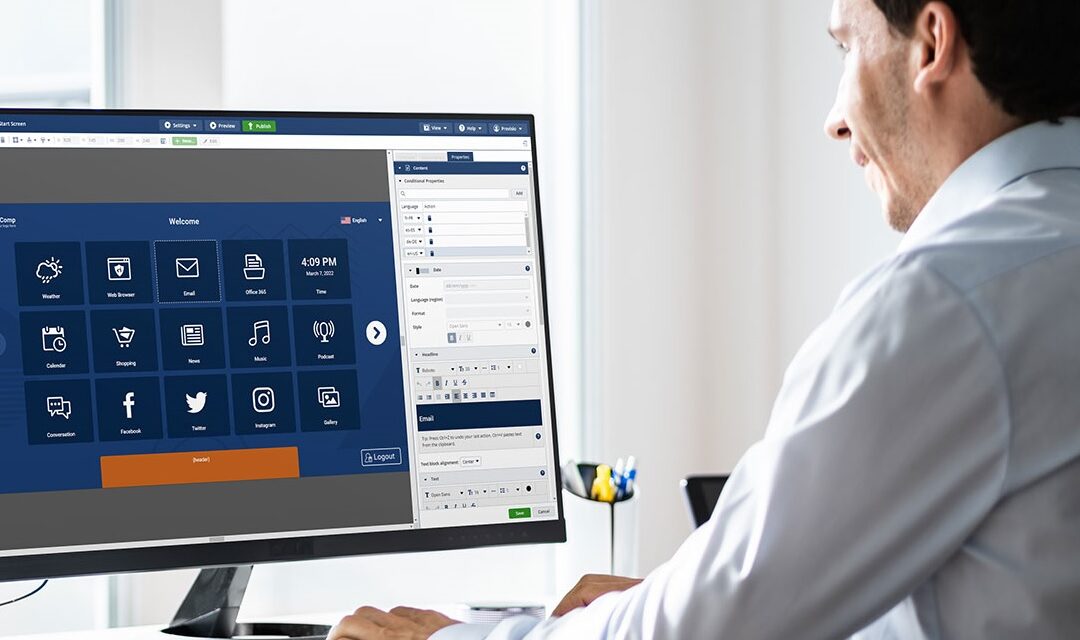In the fast-paced digital age, self-service kiosks have become indispensable tools for businesses, offering convenience, efficiency, and enhanced customer experiences. With the rise of interactive digital signage and touchscreen kiosks, managing these devices has evolved as well. In this blog post, we dive into the world of simplified kiosk management and explore the benefits of remote management features and functions. From digital signage software to touchscreen software, we unravel the secrets of streamlining simplified kiosk management for businesses of all sizes.
Self-service kiosks are often deployed in various locations, sometimes spread across a wide geographic area. Managing these kiosks manually on-site can be time-consuming and costly. With remote management, administrators can centrally monitor and control multiple kiosks simultaneously, reducing the need for physical visits and minimizing operational expenses. Remote management allows administrators to monitor the status and performance of kiosks in real-time. They can quickly identify any issues or malfunctions, enabling faster response times and reducing downtime. This proactive approach of simplified kiosk management helps ensure that kiosks are operational and available for users when they need them.
Kiosks often require software updates, security patches, or maintenance tasks. Instead of updating each kiosk individually, remote management allows administrators to push updates and perform maintenance tasks across all kiosks remotely. This streamlines the process, ensuring that all kiosks are running the latest software and security protocols. When a kiosk encounters a problem, remote management tools enable administrators to diagnose issues remotely. They can access logs, system information, and other diagnostic tools to troubleshoot problems without physically being at the kiosk location. This capability significantly reduces the time and effort needed to resolve issues. By addressing issues promptly and performing maintenance remotely, downtime is minimized, leading to a better user experience. Users will have more reliable access to kiosk services, fostering trust in the kiosk system and encouraging continued usage.

Remote management systems, like SiteKiosk Online for simplified kiosk management, provide detailed analytics and reporting features. These insights help administrators understand kiosk usage patterns, popular services, and user behavior. This data can be used to optimize the kiosk’s performance, tailor services to user preferences, and make data-driven decisions. Self-service kiosk deployments can grow quickly, especially in large organizations or public spaces. Remote management offers the scalability needed to handle an expanding kiosk network efficiently. Administrators can easily add or remove kiosks from the system without complex on-site configurations.
Overall, simplified kiosk management and remote monitoring is a critical component of self-service kiosk deployments as it streamlines operations, improves maintenance efficiency, enhances security, and ensures a seamless experience for both administrators and end-users.
Keep reading to explore the top 10 Remote Management Features and Functions simplify kiosk deployments:

1. The Evolution of Kiosk Management
Gone are the days of manual kiosk management. With advancements in technology, businesses now have the power to manage their kiosks remotely, no matter the location. This evolution of simplified kiosk management has brought about a revolution in efficiency, allowing for faster updates, reduced downtime, and proactive monitoring. With the release of SiteKiosk Online, the design of your interactive interfaces are configured completely remotely and published from the management portal.
2. The Role of Digital Signage Software
Digital signage software serves as the backbone of interactive displays, enabling businesses to deliver captivating content to their audience. Beyond content delivery, modern digital signage software offers comprehensive remote management functionalities, empowering businesses to control and monitor their kiosks from a centralized dashboard. The ability to schedule and publish content from SiteKiosk Online streamlines your workflow and simplest management.
3. Empowering Touchscreen Software
Touchscreen software is the gateway to user interaction with kiosks. Remote touchscreen software management allows businesses to fine-tune touch sensitivity, update touch configurations, and troubleshoot calibration issues without physically accessing the kiosk.
4. Unleashing the Power of Interactive Display Software
Interactive display software opens new dimensions of engagement, offering interactive experiences to users. With remote management capabilities, businesses can remotely update interactive content, ensuring dynamic and relevant interactions with customers.
5. Centralized Control: The Key to Efficiency
Remote kiosk management provides businesses with centralized control over their entire kiosk fleet. Whether it’s a single kiosk or a network of devices across multiple locations, administrators can deploy updates, schedule maintenance, and monitor performance from a single platform. simplified kiosk management is a crucial component.
6. Real-Time Monitoring and Analytics
Gaining insights into kiosk performance is crucial for making data-driven decisions. Remote management software equips businesses with real-time monitoring and analytics, allowing them to identify issues promptly, track user interactions, and optimize kiosk performance for enhanced customer experiences.
7. Ensuring Security and Compliance
The benefits of remote kiosk management extend to security and compliance as well. Businesses can remotely apply security updates, monitor kiosk access, and enforce compliance measures, reducing the risk of security breaches and ensuring data protection.
8. Swift Troubleshooting and Maintenance
In the event of technical glitches or maintenance requirements, remote management eliminates the need for on-site visits. Administrators can troubleshoot issues remotely, perform software updates, and execute maintenance tasks efficiently. Automatic email alerts let you know if there is a problem and can tie into your ITSM incident management system for quick resolution.
9. Customizing Content and Campaigns
Remote kiosk management facilitates the customization of content and marketing campaigns based on real-time data and user preferences. Businesses can adapt content dynamically to suit changing demands, improving engagement and conversion rates. SiteKiosk Online makes it fast and easy to publish new content to groups of kiosks.
10. Embracing the Future of Kiosk Management
As businesses continue to invest in self-service kiosks, embracing remote kiosk management is essential for staying ahead of the competition. From seamless software updates to data-driven decision-making, the power of simplified kiosk management and remote monitoring is a game-changer in the world of kiosks.
In conclusion, remote kiosk management is the driving force behind the seamless operation of self-service kiosks. Digital signage software, touchscreen software, and interactive display software all play crucial roles in streamlining kiosk management processes. By harnessing the potential of remote management features and functions, businesses can elevate their kiosk experiences, delight customers, and unlock new levels of efficiency in the digital era.

